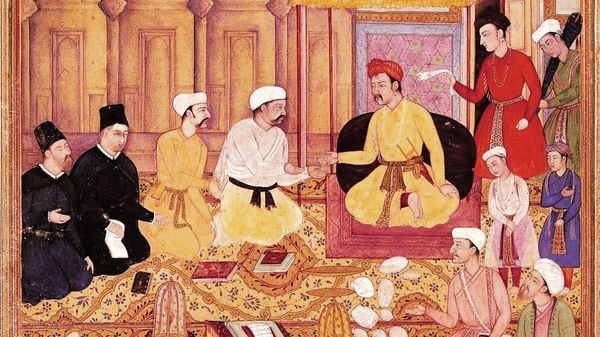| Smash 2024 Sectional test 6 Q18.“In medieval Indian history Akbar was unique for his religio-political ideas and policies.” Analyze this statement. |
Emperor Akbar (1556–1605) stands out in Indian history as a ruler who sought not merely political conquest but spiritual integration of a diverse society. As his court historian Abul Fazl wrote in the Ain-i-Akbari, “The pursuit of reason and rejection of bigotry is the foundation of Sulh-i-Kul.”
Main aspects of Akbar’s religious syncretism
- Sulh-i-Kul (Universal Peace): Abolished jizya and pilgrim tax, promoted tolerance among all faiths.
- Ibadat Khana (1575): Built at Fatehpur Sikri for religious debates—first among Muslim sects, later Hindus, Jains, Zoroastrians, Christians, atheists.
- Din-i-Ilahi (1582): It was not a formal religion but an ethical-spiritual code that stressed:
- Piety: Living a morally upright and disciplined life.
- Compassion: Practising kindness and empathy towards others.
- Unity: Promoting harmony and fellowship across different faiths.
- Influence of Sufism: Inspired by Chishti saints (Ajmer); adopted universal brotherhood and spiritual tolerance into state policy.
- Respect for Hindu Traditions: Commissioned Persian translations (Razmnama, Ramayana), celebrated festivals, permitted temples, and forged Rajput alliances.
- Engagement with Jainism: Influenced by Hiravijaya Suri; banned animal slaughter during Jain festivals, promoted non-violence.
| Significance | Limitations |
| Promoted tolerance through Sulh-i-Kul (Abolition of jizya, 1564). | Faced resistance from orthodox ulema (Sheikh Ahmad Sirhindi’s opposition). |
| Helped in political integration of diverse groups (Rajput alliances, Raja Man Singh as noble). | Din-i-Ilahi had very few followers (Birbal, Abul Fazl). |
| Encouraged interfaith dialogue and learning (Ibadat Khana debates, Jesuit missionaries 1579). | Policies remained court-centric, not mass-based (limited impact outside nobility). |
| Fostered cultural synthesis in literature and art (Persian translation of Mahabharata – Razmnama). | Reforms were personal, not institutionalised (dependent on Akbar’s charisma). |
| Enhanced legitimacy of Mughal rule in plural society (wider acceptance by Hindus, Jains, Parsis). | Lacked continuity under later Mughals (Aurangzeb reversed many policies). |
As modern historian Irfan Habib notes, “Akbar’s genius lay not in theology but in statesmanship, using tolerance as an instrument of empire-building.”
Toppers’ Way
- Theological Experiments
- Established the Ibadat Khana (1575) at Fatehpur Sikri for interfaith debates among Muslims, Hindus, Jains, Christians, Zoroastrians, and atheists.
- Created the Din-i-Ilahi (1582), an ethical-spiritual order stressing piety, loyalty to the emperor, vegetarianism, and rejection of sectarianism.
- Advanced the idea of Tauhid-i-Ilahi (Unity of God), placing God above sectarian distinctions.
- Political Integration
- Abolished jizya (1564) and pilgrim tax, removing markers of discrimination.
- Pursued alliances with Rajputs, inducting them into high positions in the Mughal administration.
- Enforced Sulh-i-Kul as a state principle, ensuring equal respect for all communities.
- Cultural and Intellectual Syncretism
- Commissioned Persian translations of Hindu texts like the Mahabharata (Razmnama), Ramayana, and Yoga Vashishta.
- Patronised scholars like Abul Fazl, who systematised Sulh-i-Kul in the Ain-i-Akbari.
- Encouraged dialogue with Jesuit missionaries (1579 onwards) and Jain monks, enriching cross-cultural exchanges.
- Social-Ethical Measures
- Influenced by Jain monk Hiravijaya Suri, ordered bans on animal slaughter during Paryushan and promoted vegetarianism.
- Drew from Sufi ideals of universal brotherhood, devotion, and tolerance, embedding them into governance.
- Fostered inter-communal harmony by discouraging forced conversions and promoting justice for all.
- Ritual and Court Culture
- Borrowed Zoroastrian practices like fire altars, sun worship, and Nauroz celebrations, blending Persian influences.
- Introduced rituals such as sijda (prostration before the emperor) and solar birthday celebrations, elevating the emperor as a unifying moral authority.


